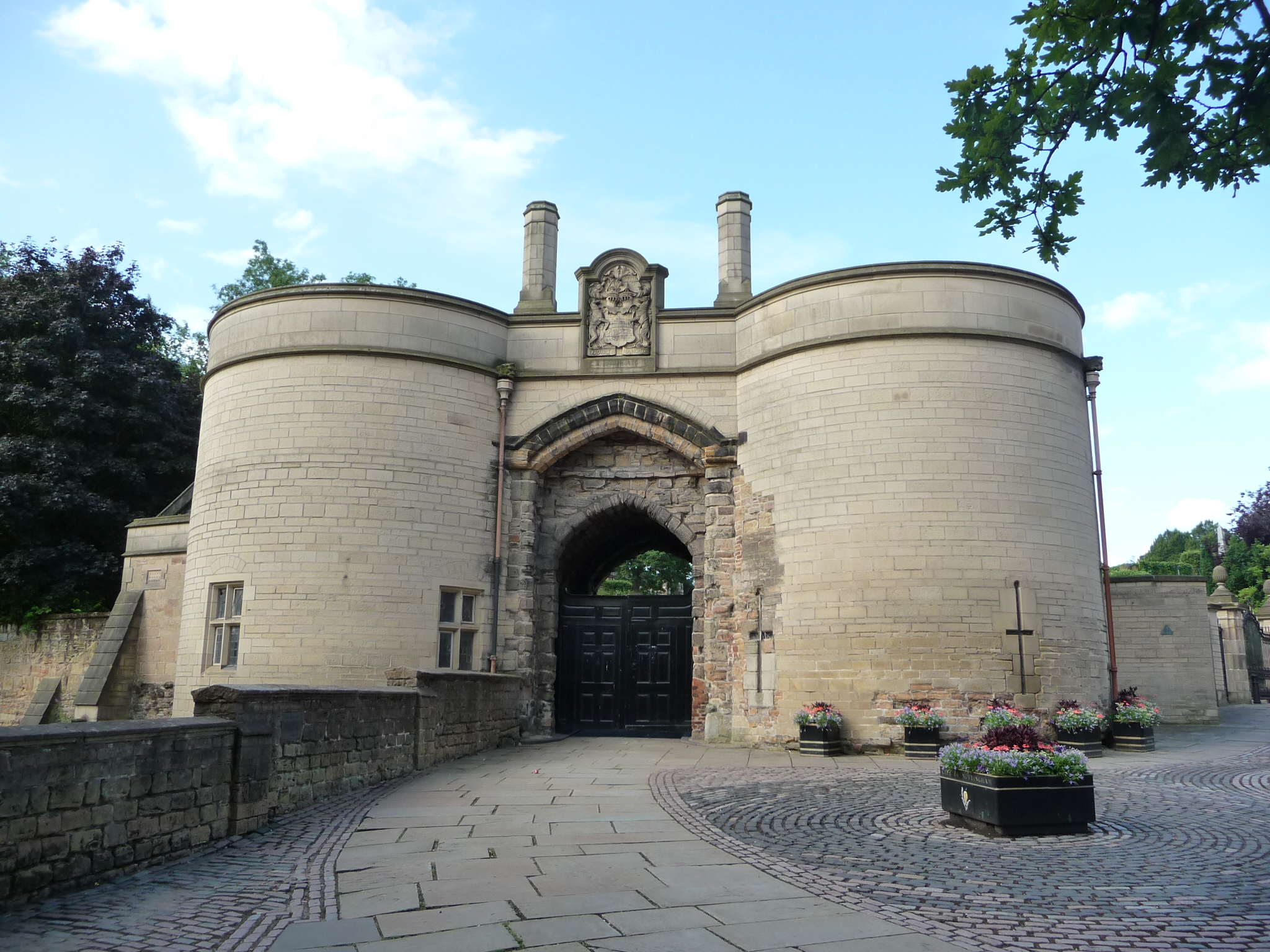|
Corn Exchange, Nottingham
The Corn Exchange is a commercial building in Thurland Street, Nottingham, Nottinghamshire, England. The structure, which is now used as an events venue, is a Grade II listed building. History Until the mid-19th century, corn merchants in Nottingham carried out their trade in the northwest corner of the Nottingham Exchange. In the early 1840s, a group of local businessmen decided to form a private company, to be known as the "Nottingham Corn Exchange Company", to finance and commission a purpose-built corn exchange for the town. The site they selected had been occupied by Thurland Hall, which dated from 1458, but was demolished in the 1830s. Henry Pelham-Clinton, 4th Duke of Newcastle, whose seat was at Clumber Park, gave permission for his land to be used in 1845. The building was designed by Thomas Chambers Hine in the Italianate architecture, Italianate style, built in red brick with ashlar stone dressings at a cost of £3,000, and was officially opened on 6 April 1850. The d ... [...More Info...] [...Related Items...] OR: [Wikipedia] [Google] [Baidu] |
Nottingham
Nottingham ( , East Midlands English, locally ) is a City status in the United Kingdom, city and Unitary authorities of England, unitary authority area in Nottinghamshire, East Midlands, England. It is located south-east of Sheffield and north-east of Birmingham. Nottingham is the legendary home of Robin Hood and to the lace-making, bicycle and Smoking in the United Kingdom, tobacco industries. The city is also the county town of Nottinghamshire and the settlement was granted its city charter in 1897, as part of Queen Victoria's Diamond Jubilee celebrations. In the 2021 United Kingdom census, 2021 Census, Nottingham had a reported population of 323,632. The wider conurbation, which includes many of the city's suburbs, has a population of 768,638. It is the largest urban area in the East Midlands and the second-largest in the Midlands. Its Functional Urban Area, the largest in the East Midlands, has a population of 919,484. The population of the Nottingham/Derby metropolitan a ... [...More Info...] [...Related Items...] OR: [Wikipedia] [Google] [Baidu] |
Quoin
Quoins ( or ) are masonry blocks at the corner of a wall. Some are structural, providing strength for a wall made with inferior stone or rubble, while others merely add aesthetic detail to a corner. According to one 19th-century encyclopedia, these imply strength, permanence, and expense, all reinforcing the onlooker's sense of a structure's presence. Stone quoins are used on stone or brick buildings. Brick quoins may appear on brick buildings, extending from the facing brickwork in such a way as to give the appearance of generally uniformly cut ashlar blocks of stone larger than the bricks. Where quoins are decorative and non-load-bearing a wider variety of materials is used, including timber, stucco, or other cement render. Techniques Ashlar blocks In a traditional, often decorative use, large rectangular ashlar stone blocks or replicas are laid horizontally at the corners. This results in an alternate, quoining pattern. Alternate cornerstones Courses of large and smal ... [...More Info...] [...Related Items...] OR: [Wikipedia] [Google] [Baidu] |
Corn Exchanges In England
Corn exchanges are distinct buildings which were originally created as a venue for corn merchants to meet and arrange pricing with farmers for the sale of wheat, barley, and other corn crops. The word "corn" in British English denotes all cereal grains, such as wheat and barley. With the repeal of the Corn Laws in 1846, a large number of corn exchanges were built in England, particularly in the corn-growing areas of Eastern England. However, with the fall in price of English corn as a result of cheap imports, corn exchanges mostly ceased to be built after the 1870s. Increasingly they were put to other uses, particularly as meeting and concert halls. Many found a new lease of life in the early 20th century as cinemas. Following the Second World War, many could not be maintained, and they were demolished. In the 1970s their architectural importance came to be appreciated, and most of the surviving examples are listed buildings. Most of the surviving corn exchanges have now been res ... [...More Info...] [...Related Items...] OR: [Wikipedia] [Google] [Baidu] |
Jongleurs (comedy Club)
Jongleurs is a chain of comedy clubs in the United Kingdom, running since 1983. The business is now owned by Kev Orkian. Early years Maria Kempinska established and opened the first Jongleurs club in 1983 in Battersea, London. In 1985 Kempinska met her business partner John Davy and they went on to create a number of comedy clubs around the UK in the following years. By 2000, there were eight Jongleurs venues across the UK. Regent Inns plc, the owners of Walkabout & Surfer's Paradise (bar & club), Walkabout, bought the clubs. Kempinska and Davy retained certain rights to the brand name, as well as creative control over booking acts. With Regent Inns in financial trouble, the Cardiff venue was closed in January 2009 and in October that year, Regent Inns went into prepacked administration, allowing for a management buy-out which resulted in the formation of Intertain UK. As a result of this administration, Jongleurs venues in Southampton, Nottingham, Bristol, Oxford and Bow, L ... [...More Info...] [...Related Items...] OR: [Wikipedia] [Google] [Baidu] |
Stereolab
Stereolab are an English people, Anglo-French avant-pop band formed in London in 1990. Led by the songwriting team of Tim Gane and Lætitia Sadier, the group's sound incorporates repetitive motorik beats with the use of vintage electronic keyboards and female vocals sung in English and French, drawing influences from krautrock, funk, jazz, 1960s Yé-yé, French pop and Brazilian music. Their lyrics have political and philosophical themes influenced by the Surrealist and Situationist International, Situationist art movements. Stereolab were formed by Gane (guitar and keyboards) and Sadier (vocals, keyboards and guitar) after the break-up of McCarthy (band), McCarthy. The two were romantically involved for fourteen years and are the group's only consistent members. Other longtime members included 1992 addition Mary Hansen (backing vocals, keyboards and guitar), who died in 2002, and 1993 addition Andy Ramsay (drums). The High Llamas' leader Sean O'Hagan (guitar and keyboards) was ... [...More Info...] [...Related Items...] OR: [Wikipedia] [Google] [Baidu] |
Avant-pop
Avant-pop is popular music that is experimental, new, and distinct from previous styles while retaining an immediate accessibility for the listener. The term implies a combination of avant-garde sensibilities with existing elements from popular music in the service of novel or idiosyncratic artistic visions. Definition "Avant-pop" has been used to label music which balances experimental or avant-garde approaches with stylistic elements from popular music, and which probes mainstream conventions of structure or form. Writer Tejumola Olaniyan describes "avant-pop music" as transgressing "the boundaries of established styles, the meanings those styles reference, and the social norms they support or imply." Music writer Sean Albiez describes "avant-pop" as identifying idiosyncratic artists working in "a liminal space between contemporary classical music and the many popular music genres that developed in the second half of the twentieth century." He noted avant-pop's basis in experi ... [...More Info...] [...Related Items...] OR: [Wikipedia] [Google] [Baidu] |
Independent Labour Party
The Independent Labour Party (ILP) was a British political party of the left, established in 1893 at a conference in Bradford, after local and national dissatisfaction with the Liberal Party (UK), Liberals' apparent reluctance to endorse working-class candidates. A sitting independent MP and prominent union organiser, Keir Hardie, became its first chairman. The party played a key role in the formation of the Labour Representation Committee (1900), Labour Representation Committee, to which ILP members Hardie and Ramsay MacDonald were delegates at its foundation in 1900. The committee was renamed the Labour Party (UK), Labour Party in 1906, and the ILP remained affiliated until 1932. In 1947, the organisation's three parliamentary representatives defected to the Labour Party, and the organisation joined Labour as Independent Labour Publications in 1975. Organisational history Background As the nineteenth century came to a close, working-class representation in political office ... [...More Info...] [...Related Items...] OR: [Wikipedia] [Google] [Baidu] |
Nottingham Society Of Artists
The Nottingham Society of Artists is an art society in the city of Nottingham, England. It was founded in 1880. The society is located at 71–73 Friar Lane, near Nottingham Castle Nottingham Castle is a Stuart Restoration-era ducal mansion in Nottingham, England, built on the site of a Normans, Norman castle built starting in 1068, and added to extensively through the medieval period, when it was an important royal fortr ... and adjacent to the Friar Lane Gallery. The Nottingham-based painter Arthur Spooner (1873–1962) was formerly a member of the society. References External links Nottingham Society of Artists website Arts organizations established in 1880 1880 establishments in England Organisations based in Nottingham Culture in Nottingham English art Art societies {{Art-org-stub ... [...More Info...] [...Related Items...] OR: [Wikipedia] [Google] [Baidu] |
Parapet
A parapet is a barrier that is an upward extension of a wall at the edge of a roof, terrace, balcony, walkway or other structure. The word comes ultimately from the Italian ''parapetto'' (''parare'' 'to cover/defend' and ''petto'' 'chest/breast'). Where extending above a roof, a parapet may simply be the portion of an exterior wall that continues above the edge line of the roof surface, or may be a continuation of a vertical feature beneath the roof such as a fire wall or party wall. Parapets were originally used to defend buildings from military attack, but today they are primarily used as guard rails, to conceal rooftop equipment, reduce wind loads on the roof, and to prevent the spread of fires. Parapet types Parapets may be plain, embattled, perforated or panelled, which are not mutually exclusive terms. *Plain parapets are upward extensions of the wall, sometimes with a coping at the top and corbel below. *Embattled parapets may be panelled, but are pierced, if not ... [...More Info...] [...Related Items...] OR: [Wikipedia] [Google] [Baidu] |
Cornice
In architecture, a cornice (from the Italian ''cornice'' meaning "ledge") is generally any horizontal decorative Moulding (decorative), moulding that crowns a building or furniture element—for example, the cornice over a door or window, around the top edge of a pedestal, or along the top of an interior wall. A simple cornice may be formed with a crown, as in crown moulding atop an interior wall or above kitchen cabinets or a bookcase. A projecting cornice on a building has the function of throwing rainwater free of its walls. In residential building practice, this function is handled by projecting gable ends, roof eaves, and rain gutter, gutters. However, house eaves may also be called "cornices" if they are finished with decorative moulding. In this sense, while most cornices are also eaves (overhanging the sides of the building), not all eaves are usually considered cornices. Eaves are primarily functional and not necessarily decorative, while cornices have a decorative a ... [...More Info...] [...Related Items...] OR: [Wikipedia] [Google] [Baidu] |
Modillion
A modillion is an ornate bracket, more horizontal in shape and less imposing than a corbel. They are often seen underneath a Cornice (architecture), cornice which helps to support them. Modillions are more elaborate than dentils (literally translated as small teeth). All three are selectively used as adjectival historic past participles (''corbelled, modillioned, dentillated'') as to what co-supports or simply adorns any high structure of a building, such as a terrace of a roof (a flat area of a roof), parapet, pediment/entablature, balcony, cornice band or roof cornice. Modillions occur classically under a Corinthian order, Corinthian or a Composite order, Composite cornice but may support any type of eaves cornice. They may be carved or plain. See also * Glossary of architecture Gallery Abbaye Ste Foy à Conques (25) - Frises et corbeaux du chevet.jpg, Modillions carved with animal heads in the Abbaye Ste Foy in Conques (France). 20130809 dublin036.JPG, Trinity College, in Du ... [...More Info...] [...Related Items...] OR: [Wikipedia] [Google] [Baidu] |







